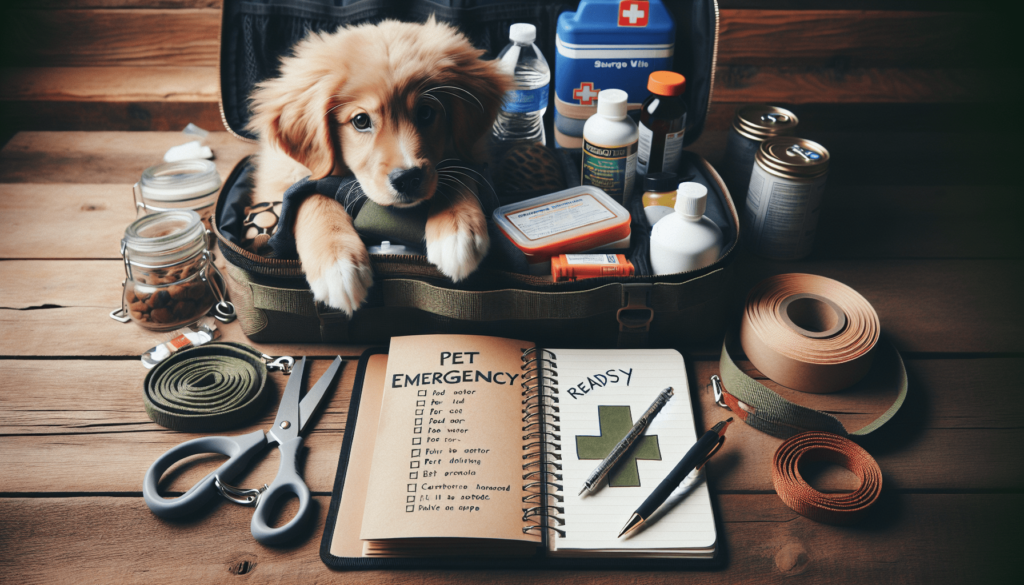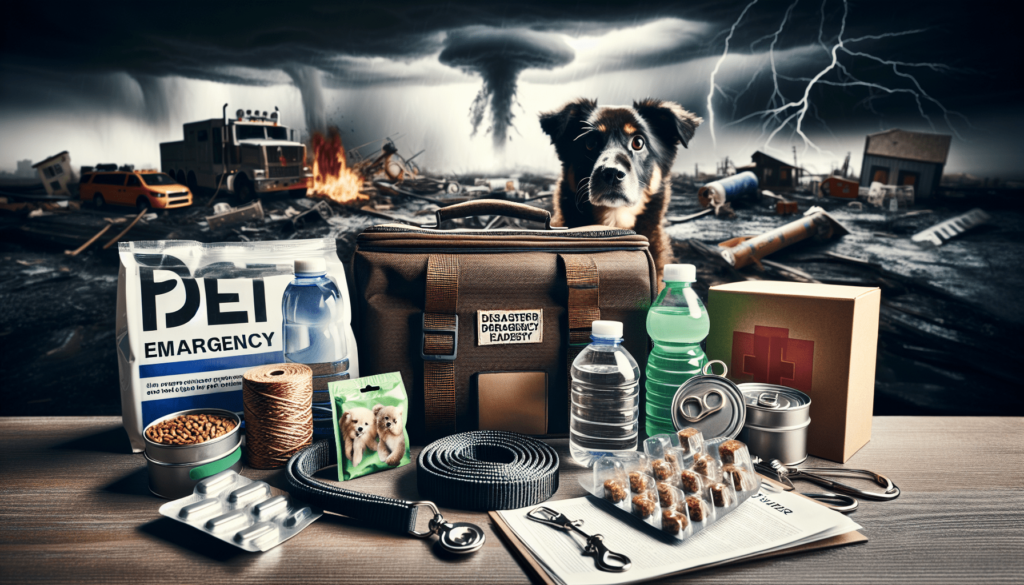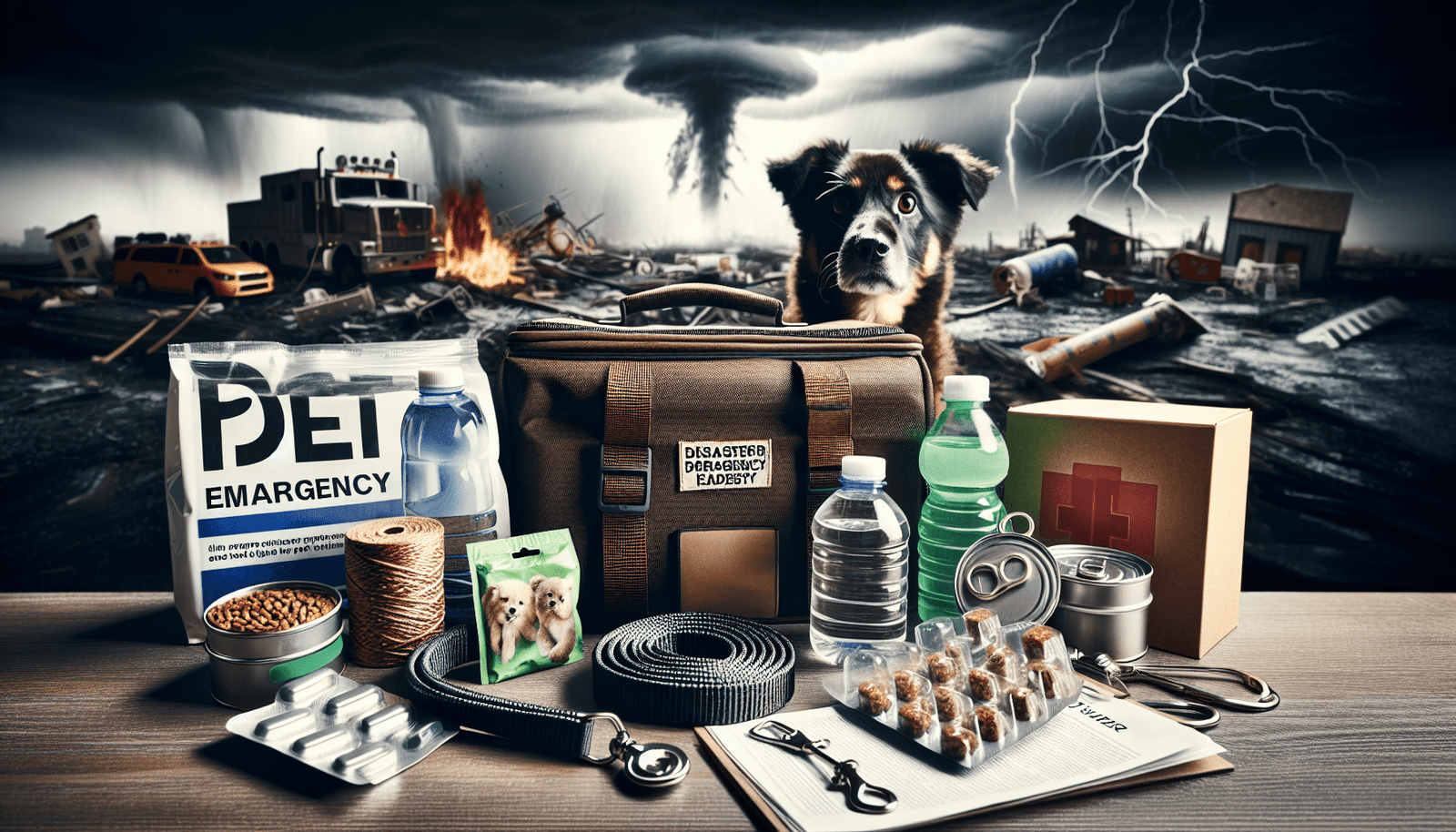Imagine being prepared for any emergency, not just for yourself but for your furry friends as well. In the article “Disaster Prep For Pets: Keep Your Furry Friends Safe In Any Emergency,” you’ll find valuable information on how to ensure the safety and well-being of your pets in times of crisis. From learning how to create a self-sufficient environment to acquiring essential survival skills, this article will guide you through the journey of disaster preparedness for both you and your beloved pets. So, get ready to embrace self-reliance and find out how to keep your furry companions safe, no matter what challenges may come your way.

Importance of Disaster Prep for Pets
Disasters and emergencies can strike at any moment, and it’s crucial to ensure the safety and well-being of our furry friends in those situations. Pets are vulnerable and rely on their owners for their safety and care. That’s why preparing for emergencies is not only important but also necessary to protect our beloved pets.
Creating an Emergency Evacuation Plan
One of the first steps in disaster preparedness for pets is to create an emergency evacuation plan. This involves identifying pet-friendly evacuation shelters in your area where you can take your pets in case of an emergency. It’s essential to research and have a list of these locations readily available so that you can act quickly when the need arises.
In addition to knowing where to go, packing an emergency kit specifically for your pet is vital. This should include essential items such as food, water, medication, and medical supplies that can sustain your pet for at least three days. It’s crucial to consider your pet’s specific needs and pack accordingly.
Another essential part of your emergency evacuation plan is ensuring that your pet has proper identification. This includes having a collar with updated information, such as your contact details, and a tag with your pet’s name. It’s also recommended to have your pet microchipped and to make sure that the chip information is kept up to date.
Lastly, if you find yourself unable to evacuate in an emergency, it’s crucial to make arrangements for your pet’s care. This may involve asking a trusted friend or family member if they can take care of your pet temporarily or identifying a reliable pet-sitting service that can help in such situations.
Stocking Up on Essential Supplies
When it comes to disaster prep for pets, stocking up on essential supplies is of utmost importance. This includes having an ample supply of food and water that can last for at least three days. Make sure you store these supplies in a safe and accessible place so that they are readily available when needed.
Additionally, it’s essential to have enough medication and medical supplies for your pet. If your pet requires any regular medication, make sure you have a sufficient amount stored in your emergency kit. You should also include basic medical supplies such as bandages, antiseptics, and any other items specific to your pet’s needs.
To provide comfort to your pet during a crisis, consider including items that bring reassurance. This can include favorite toys, blankets, or other familiar scents that can help keep your pet calm in a stressful situation. Don’t underestimate the power of these simple items in providing comfort and emotional support to your pet during emergencies.
Lastly, ensure that you have extra leashes, harnesses, and carriers on hand. These items are crucial for safely transporting your pet in case of an evacuation, and it’s always a good idea to have backups available.
Emergency Communication and Contact Information
Having a list of emergency contacts specifically for your pet is essential in disaster preparedness. These contacts should include your veterinarian’s information, as well as local animal shelters or rescue organizations. In case of an emergency, these contacts can provide valuable guidance and assistance in taking care of your pet’s well-being.
It’s also crucial to ensure that your pet’s microchip information is up to date. Microchipping provides an additional layer of identification and increases the chances of being reunited with your pet if you become separated during a crisis. Double-check that the information associated with the microchip is accurate and that you have any necessary registration documents readily available.
Another important document to keep easily accessible is your pet’s vaccination records. In emergency situations, it may be necessary to provide proof of vaccinations, especially if your pet needs to be temporarily housed in a shelter or with a caretaker. Keep these records in a waterproof bag or folder, along with any other important documents relevant to your pet’s health and identification.

Preparing Your Home for Pet Safety
While planning for evacuations is crucial, it’s also essential to prepare your home to ensure your pet’s safety in case you need to shelter in place during an emergency. Start by securing loose items and potential hazards in your home. These can include heavy furniture, fragile objects, and toxic substances that can harm your pet.
Creating a safe space for your pet is another important step in disaster preparedness. This can be a designated area in your home where your pet can feel secure and comfortable. Include items like bedding, food, water, and toys in this space. It’s also a good idea to have a crate or carrier available in case you need to quickly transport your pet within your home or during an evacuation.
To alert emergency responders of the presence of a pet in your home, display a pet alert sticker on your front door or window. These stickers are designed to inform rescue personnel that there are animals inside that may need assistance. Make sure the sticker is easily visible and includes the types and number of pets in your home.
Practicing evacuation drills with your pet is essential for their safety and your peace of mind. This ensures that both you and your pet are familiar with the process and can evacuate efficiently if necessary. Practice how to safely secure your pet in a carrier or on a leash, and establish a predetermined meeting point outside your home. Regular practice will help reduce stress for both you and your pet during an actual emergency.
Disaster Prep for Specific Types of Pets
Different types of pets may require specific considerations and preparations during emergencies. Here are some guidelines for caring for specific types of pets:
Caring for dogs during emergencies
Dogs are generally more adaptable to emergency situations but still require careful preparation. Make sure you have a sturdy leash and harness for each dog, as well as a backup collar with identification. Have an ample supply of dog food and water, as well as any necessary medications and bedding.
Managing the welfare of cats in emergency situations
Cats can be more challenging to handle in emergency situations, as they are generally more independent. Make sure your cat has a secure carrier or crate available for transport. Pack enough cat food, water, and litter for at least three days. Additionally, have a plan in place to secure your cat indoors, away from potential dangers during an emergency.
Prepping for emergencies with small pets, like hamsters or guinea pigs
Small pets like hamsters or guinea pigs may require special attention during emergencies. Ensure that their enclosures or cages are secure and have enough bedding, water, and food available. Have a portable travel cage or carrier on hand in case you need to evacuate with your small pet.
Ensuring the safety of birds during disasters
Birds have unique considerations when it comes to disaster preparedness. Have a secure travel cage or carrier available for your bird, along with enough food and water to last for at least three days. Keep in mind that birds are sensitive to fumes, so avoid using chemicals or exposing them to smoke during emergencies.
Emergency First Aid for Pets
In emergency situations, it’s crucial to be able to recognize signs of distress and injury in your pet. Knowing how to perform basic first aid can make a significant difference in your pet’s well-being. Some essential skills to learn include CPR for pets, bandaging wounds, and recognizing signs of dehydration or heatstroke.
However, it’s important to note that while basic first aid can be helpful, there are limits to what you can do on your own. Knowing when to seek professional veterinary care is essential. If your pet’s condition worsens or if you are unsure about how to handle a specific situation, contact your veterinarian or an emergency veterinary clinic immediately.
Pet Safety During Natural Disasters
Natural disasters such as hurricanes, wildfires, floods, and earthquakes present specific challenges when it comes to pet safety. Here are some tips for caring for your pets during these events:
Preparing for hurricanes and tropical storms
If you live in an area prone to hurricanes or tropical storms, it’s crucial to have a plan in place for your pet’s safety. Stay informed about evacuation orders and have a pet-friendly place to go if necessary. Make sure to secure your home and belongings, and keep your pet calm and comfortable during the storm.
Keeping pets safe during wildfires
During wildfires, it’s essential to follow evacuation orders and prioritize the safety of both you and your pets. Keep your pets indoors, away from smoke and fire. If you need to evacuate, follow the instructions of local authorities and bring your pet’s emergency kit with you.
Protecting pets from floods and heavy rains
During floods and heavy rains, it’s important to keep pets away from flooded areas and rising waters. If you need to evacuate, take your pet with you and avoid leaving them behind. Keep your emergency kit easily accessible and make sure your pet’s identification is secure.
Managing pet safety during earthquakes
Earthquakes can be unpredictable, and it’s crucial to have a plan in place for your pet’s safety during these events. Secure loose items that can pose a danger to your pet, and create a safe space where they can seek shelter during the earthquake. Practice earthquake drills with your pet to ensure their safety and well-being.
Caring for Pets in Power Outages
Power outages can occur during emergencies and may last for an extended period. It’s important to be prepared to care for your pets during these situations. Here are some tips:
Maintaining a backup power supply for essential pet equipment
Having a backup power supply, such as a generator or alternative energy source, can help ensure that essential pet equipment continues to function during a power outage. This includes items such as heating or cooling systems, filtration systems for fish tanks, or any other equipment that your pet relies on for their well-being.
Keeping pets cool or warm during power outages
Depending on the season, it’s essential to keep your pets cool or warm during power outages. In hot weather, provide ample ventilation, access to shade, and plenty of fresh water. In cold weather, provide warm bedding, blankets, or even heated pads to keep your pets comfortable and prevent hypothermia.
Ensuring proper food and water storage without electricity
When dealing with a power outage, it’s important to ensure that you have proper food and water storage for your pets. Consider storing dry pet food in airtight containers to keep it fresh and prevent spoilage. Have a supply of bottled water specifically for your pets, and make sure to regularly check and replenish it if needed.
Providing mental stimulation for pets during blackouts
Power outages can be stressful for pets, especially when they are confined indoors. Providing mental stimulation, such as interactive toys or puzzles, can help keep your pets occupied and alleviate stress. Spending quality time with your pets, engaging in play or gentle grooming, can also provide comfort during this challenging time.
Post-Disaster Pet Reunification
In the aftermath of a disaster, efforts to reunite lost pets with their owners become crucial. Here are some steps to take during the post-disaster period:
Search and rescue efforts for missing pets
If your pet becomes lost during a disaster, it’s important to initiate search and rescue efforts as soon as possible. Post flyers in your neighborhood, contact local animal shelters and rescue organizations, and make use of online resources to spread the word about your missing pet.
Contacting local animal shelters and organizations
Contacting local animal shelters and organizations should be one of the first steps if you cannot find your pet after a disaster. Provide them with a detailed description of your pet, including any specific identifiable features. Stay in regular contact with these organizations and keep them informed about any developments.
Using online resources for pet reunion
In today’s digital age, online resources can be invaluable for reuniting lost pets with their owners. Utilize social media platforms, local lost and found pet websites, and online community groups to share information about your missing pet. Be sure to include clear photos and contact information to facilitate a quick reunion.
Steps to take when you find a lost pet
If you come across a lost pet during the post-disaster period, there are steps you can take to help reunite them with their owner. Safely approach the animal if possible, and check for any identification like tags or microchips. If you can’t find the owner immediately, contact local animal control or a nearby animal shelter to assist with the situation.
Disaster prep for pets is vital to ensure their safety and well-being in any emergency. By following these guidelines and taking the necessary precautions, you can minimize the risks and provide the best care for your furry friends when they need it most. Remember, being prepared is the key to safeguarding your pets in challenging times, and your efforts will be rewarded with their safety and comfort.

